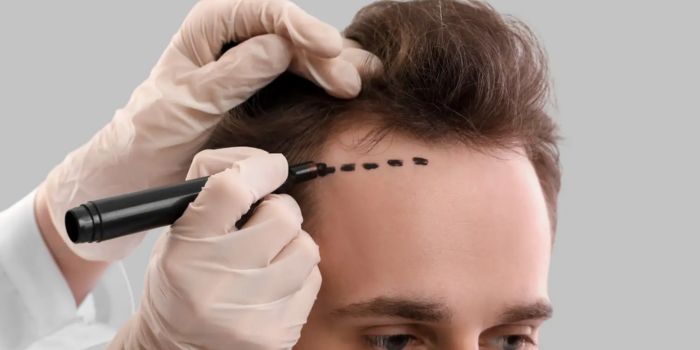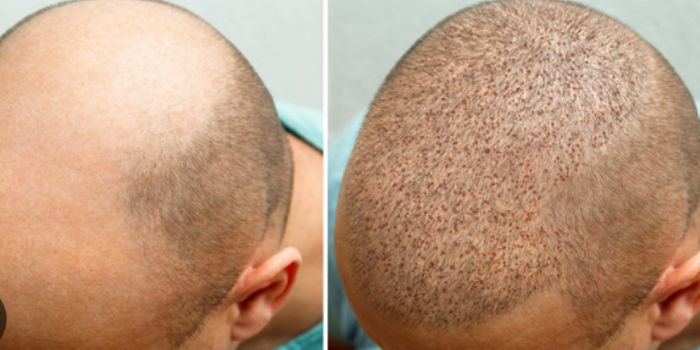I am frequently asked what to anticipate throughout the healing process because I am a hair restoration surgeon with over 7 years of experience doing hair transplants. It makes sense that patients would want to know when surgery will take place, whether there will be any adverse effects, and how to take care of their scalp in order to promote the best possible healing. Let’s read below about “What to Expect During Hair Transplant Recovery: A Complete Guide”.
I’ll offer my expertise and practical experience in this extensive guide to help you get ready for your upcoming hair transplant adventure.
Table of Contents
Immediately After Surgery
Your scalp will be sore, swollen, and probably covered with crusts and scabs at the graft sites after the hair transplant procedure. For the first 24 hours, you can possibly have some little bleeding. This is a very typical occurrence.
For the initial few days of recovery, consider the following advice:
Head Wrappings: To protect the transplantation sites and promote healing, your head will be covered in specialty bandages right away following surgery. It is recommended to wear these wrappings securely for the first 72 hours or more. Remove them only as directed by me in order to gently cleanse the scalp.
Medications: In order to keep you comfortable while you recuperate, I will prescribe painkillers and medicines to stave off infection. For best effects, make sure you take these drugs on time. It is necessary to take antibiotics and anti-inflammatories for a minimum of one week.
Sleep Position: For the first four nights, sleep on your back with your head raised to reduce edema and stop the new grafts from coming loose.
Activity Restrictions: For 10–14 days following surgery, refrain from vigorous activity and exercise. Healing may be impacted by activities that increase blood pressure or heart rate. You’ll need to rest a lot while your scalp heals.
The First Week
In the week following your hair transplant, you should anticipate:
Itching and Tingling Sensations: You may experience tingling, itching, numbness, or a “pins and needles” sensation when the skin surrounding graft sites heals and nerve endings regenerate. This is not unusual and should not raise any red flags. To relieve inflammation, gently massage the affected region using vitamin E oil. Never pick or scratch scabs!
Scab Formation Around Grafts: As a crucial component of healing, protective scabs will form around the transplantation sites in 5-7 days. Fight the impulse to pick or peel them too soon!
Swelling and Bruising: Days 2-4 following surgery are when moderate skin edema and bruising usually reach their peak. Apply cold compresses to ease the pain. Get in touch with my office right away if your swelling is significant or getting worse.
Redness and Crusting: For the first seven to ten days, the scalp around the grafts and suture sites will appear red and crusty. Wash your scalp twice a day with my medicated shampoo to keep it clean. Grafts may be moved before they fully anchor if they are scrubbed too hard.
As a skilled hair restoration surgeon, I always plan a follow-up appointment for one week after surgery to thoroughly examine each patient’s scalp, administer microneedling to increase the success rate of grafts, and address any concerns they may have about their recuperation.
Weeks Two to Four
Following surgery, during the second, third, and fourth weeks, you should anticipate:
Scabs Separating from Grafts: As the transplantation sites heal, the protective scab tissue will start to pull away from the scalp around days 10 to 16. Avoid pushing on loose scabbing tissue fragments to avoid unintentionally removing grafts before they have had time to firmly anchor! Let scabs fall off on their own.
Itching and Dryness: As the scalp adjusts and nerve endings renew, itching is frequently experienced. For relief, apply vitamin E oil and give your scalp a light massage. Flaking and temporary dandruff are other common reactions that go away as the healing process continues.
Hair Shedding: If, two to four weeks following surgery, transplanted hairs start to fall out, don’t panic! This is just the natural course of growth. Hair that sheds will permanently grow back in four to six months.
Redness Fading: Swelling, sensitivity, and redness keep getting better. Discoloration and bruises may still be apparent, but they will be much paler.
Return to Non-Strenuous Activity: Desk work and other light activities can be resumed around two weeks after surgery. For the whole month, stay away from strenuous exercise, swimming, contact sports, and activities that make you perspire. Sweat can cause fresh grafts to become dislodged and cause poor absorption.
In my capacity as your surgeon, I will plan follow-up visits for two weeks, one month, and four months after surgery to assess your healing and do expert microneedling treatments to promote graft success. During your recuperation, don’t try microneedling at home.
1-4 Months After Surgery
You will go through the latter phases of healing in months 1-4:
Complete Healing of Graft Sites: By week six, the majority of patients have completely healed their outer layer of skin, free of crusts, scabs, or redness. As the nerves heal completely, occasional sensitivity, numbness, or itching may persist for two to four months after surgery.
Beginning of Hair Growth: Three to four months following transplantation is when early hair growth usually starts. But it happens gradually and slowly. If you do not notice hair growing right away, do not worry. The entire process takes eight to twelve months.
Return to Normal Activity: You can gradually resume your regular exercise regimen after a month. To avoid scalp pimples, continue to refrain from activities involving helmet contact for three months. You should be free to resume swimming and participating in sports after four months.
Ongoing Maintenance: Although most patients recover completely after four months of surgery, maintaining and growing new hair takes a lifetime. For the first year following a graft, I recommend finasteride or minoxidil to patients in order to maximize hair density. After the first year, keeping the surrounding natural hair is suggested but not required.
The significance of adhering to all post-care recommendations during your recuperation, including the planned follow-up appointments with your surgeon, cannot be overstated. As a skilled expert in hair restoration, I’m here to help you with any inquiries and worries you may have as you go back to having healthier, fuller hair.
What is Graft Success Rate?
A crucial query that many of my patients have is “what is the success rate for transplanted hair follicles, or grafts]?”
The percentage of transplanted hair follicles that firmly establish themselves in the scalp and produce new hairs is known as the graft success rate. It is necessary to use accurate extraction, preservation, and insertion techniques because not all transplanted follicles survive the transplantation process.
Elements That Affect Graft Survival Graft survival is influenced by numerous factors, such as:
- Age and condition of the patient
- Scalp laxity and hair texture
- Surgeon’s expertise and background
- preventing injury or infection while recovering
Over the past seven years, I have used cutting edge techniques including intelligent graft selection, minimally invasive Choi implanters, and strict post-operative care to achieve excellent graft success rates of 90–95% among my patients.
Methods To Increase Graft Survival
As your surgeon, it is my top priority to maximize graft uptake. I utilize these best-practices:
- Accurate follicular unit extraction safeguarding delicate grafts with cutting-edge ARTAS robotic technology
- Choi implanters for less intrusive installation lowering the damage to tissues
- Cold storage grafts to maintain the vitality of follicles
- Laser therapy after surgery to promote healing
- Regular microneedling to increase the success of grafts
The great majority of my over 2,500 hair transplant patients have seen graft success rates of 90–95% and remarkable, natural-looking results by adhering to my clinically validated methods.
Conclusion
The Final Word After a hair transplant, recovery requires patience, time, and cautious post-operative care for three to four months. On the other hand, transplanted hair will grow indefinitely after healing, giving you back your confidence and natural hairline forever.
I am your skilled hair restoration surgeon, and I am here to offer kind, considerate advice at every stage of your recuperation. Please get in touch with me at any time if you have any questions or concerns. I hope you like reading “What to Expect During Hair Transplant Recovery: A Complete Guide”.

Kannaiah Thallapally is a seasoned hair restoration expert with a strong background in advanced hair transplant techniques. As an Associate Member of the International Society of Hair Restoration Surgeons (ISHRS), Kannaiah combines his extensive knowledge with a commitment to the latest industry practices. His expertise is showcased on hairstransplant.in, where he provides valuable insights into hair restoration solutions. Kannaiah is dedicated to helping individuals achieve their desired results and restore their confidence. Connect with him on Instagram for more updates and expert tips.
